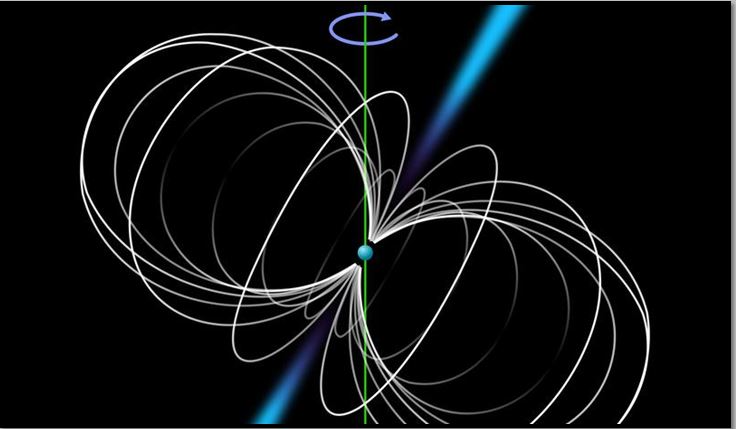Description

Disclaimer: Copyright infringement not intended.
Context
- In 1969, two research groups reported an abrupt and brief increase in the rotation rate of a pulsar; this glitch remains to be explained 44 years on; to date, physicists have spotted more than 3,000 pulsars and around 700 such glitches, and are starting to get a sense of why they happen.
Details
Discovery of Pulsars
- In 1967, Jocelyn Bell Burnell and Antony Hewish discovered the first pulsar, named PSR B1919+21, using an array of antennae to study radio waves emitted by distant stars.
- Pulsars were identified as rotating neutron stars emitting beams of radiation, with periodic pulses observed as these beams intersect Earth.
Neutron Stars and Glitches
- Neutron stars, formed from the collapsed cores of massive stars, consist of a solid crust and a core containing superfluid, a frictionless state of matter.
- In 1969, researchers reported glitches - abrupt and brief increases in the rotation rate of pulsars, challenging the prevailing understanding that pulsars only slowed down over time.
Post-Glitch Relaxation
- When scientists plotted the rotation rate of pulsars over time, glitches showed a characteristic pattern: a brief increase in rotation rate followed by a slow relaxation to the original value.
- The slow post-glitch relaxation suggested the presence of a superfluid state inside the neutron star, which led to the exploration of glitches in the context of superfluid dynamics
Superfluid Dynamics
- Superfluidsexhibit unique properties, including the ability to form vortices. In the case of a rotating neutron star, the superfluid's vortices are pinned to the nuclei in the crust.
- As the rotating neutron star loses energy to radiation, the crust slows down. The pinned vortices, however, maintain their density, resisting rearrangement.
- Eventually, the force on the vortices overcomes pinning, causing them to be thrown outward. The angular momentum lost by the superfluid is gained by the crust, resulting in a glitch in the pulsar's rotation.
Glitching Mechanism Controversies
- Several aspects of the glitching mechanism are still under debate, including the triggers in space and the evolution of glitches over time.
- The study of pulsar glitches provides a rich field for scientific inquiry, offering insights into the complex physics unfolding inside neutron stars.

Introduction to Pulsars
- Definition: Pulsars are highly magnetized, rotating neutron stars that emit beams of electromagnetic radiation out of their magnetic poles. When these beams of radiation intersect Earth, they produce periodic pulses of radiation.
- Discovery: Pulsars were first discovered by Jocelyn Bell Burnell and Antony Hewish in 1967 using radio telescopes. The discovery was initially named "LGM-1" (Little Green Men) due to its regular pulses, later identified as a natural phenomenon.
Nature and Properties:
- Neutron Stars: Pulsars are a specific type of neutron star, formed from the remnants of massive stars that have undergone supernova explosions.
- Magnetic Fields: Pulsars have incredibly strong magnetic fields, typically in the range of 10^8 to 10^15 gauss. These intense magnetic fields play a crucial role in the emission of radiation and the rotation of the pulsar.
Formation:
- Supernova Explosions: Pulsars are formed during supernova explosions, which occur when massive stars exhaust their nuclear fuel and collapse under their gravity. The outer layers are expelled, leaving behind a highly compressed core that becomes a neutron star or a pulsar.
- Angular Momentum Conservation: During the collapse, the conservation of angular momentum leads to an increase in rotation speed, resulting in the rapid rotation of the pulsar.
Pulsar Emission Mechanism:
- Magnetic-Dipole Model: The leading model for pulsar emission is the magnetic-dipole model. It involves the rotation of a strong magnetic field with the neutron star, generating beams of radiation that are observed as pulses when Earth intersects the beam.
Observations and Detection:
- Radio Waves: Pulsars were first detected in the radio frequency range, but they have since been observed across the electromagnetic spectrum, including X-rays and gamma rays.
- Pulse Periods: Pulsars exhibit extremely stable pulse periods, ranging from milliseconds to a few seconds. Changes in these periods can provide insights into the pulsar's environment and interactions.
Pulsar Variability:
- Glitches: Pulsars occasionally experience sudden increases in rotation speed known as glitches. These events are thought to result from the interaction of the pulsar's superfluid interior with its crust.
- Timing Noise: Pulsar timing observations sometimes reveal unexpected variations in pulse arrival times, known as timing noise. The origins of timing noise are still a subject of research.
Applications and Significance:
- Pulsar Timing Arrays: Pulsars are used in pulsar timing arrays to detect gravitational waves. Tiny fluctuations in pulse arrival times from multiple pulsars can indicate the passage of gravitational waves through space.
- Astrophysical Laboratories: Pulsars serve as unique astrophysical laboratories for testing theories of dense matter, general relativity, and magnetic field dynamics.
Exotic Pulsar Types:
- Magnetars: Some pulsars, known as magnetars, have extremely strong magnetic fields, even greater than typical pulsars. These objects exhibit sporadic bursts of X-rays and gamma rays, likely due to intense magnetic activity.
- Millisecond Pulsars: Pulsars with extremely short rotation periods, known as millisecond pulsars, are of particular interest. They are thought to be rejuvenated through accretion from a companion star in a binary system.
Pulsars in Binary Systems:
- Accretion: Pulsars in binary systems can undergo accretion, where they capture material from their companion star. This process can lead to changes in the pulsar's emission properties and rotation rate.
- Binary Pulsar Systems: Studying binary pulsar systems, such as the famous Hulse-Taylor binary pulsar, has provided strong evidence for the existence of gravitational waves, earning the 1993 Nobel Prize in Physics.
Pulsars and General Relativity:
- Tests of General Relativity: Pulsar systems, especially binary pulsars, provide excellent laboratories for testing predictions of general relativity.
- The precise timing of pulsar pulses allows scientists to explore the effects of gravitational interactions and confirm Einstein's theories.
Multi-Messenger Astronomy:
- Neutrinos and Gravitational Waves: Pulsars, with their unique properties and interactions, contribute to the emerging field of multi-messenger astronomy.
- Combined observations of pulsars in different wavelengths, along with neutrinos and gravitational waves, offer a more comprehensive understanding of astrophysical phenomena.
Unsolved Mysteries:
- Pulsar Magnetospheres: The detailed processes occurring within pulsar magnetospheres remain a challenge to understand fully. The generation and modulation of pulsar emissions are complex and involve interactions with the magnetosphere and surrounding medium.
- Pulsar Formation Models: Despite significant progress, the exact details of pulsar formation and the factors influencing their diverse properties are still subjects of ongoing research.
Observational Instruments:
- Radio Telescopes: Historically, pulsars were primarily detected using radio telescopes. Advances in technology have led to more sensitive instruments and increased the number of known pulsars.
- X-ray and Gamma-ray Observatories: Instruments like the Chandra X-ray Observatory and Fermi Gamma-ray Space Telescope have allowed astronomers to study pulsars in other parts of the electromagnetic spectrum.
Educational Resources:
- Pulsar Catalogs: Various catalogs, such as the ATNF Pulsar Catalog and the McGill Online Pulsar Catalog, provide comprehensive information on known pulsars.
- Educational Outreach: Pulsars offer excellent opportunities for educational outreach, helping students and the public engage with complex astrophysical concepts.

Conclusion
The study of glitches not only enhances our comprehension of pulsars but also contributes to a deeper understanding of the fundamental physics governing extreme astrophysical environments.
|
PRACTICE QUESTION
Q. How have observations of pulsar glitches contributed to our understanding of neutron stars? Discuss the implications of these phenomena in the broader context of astrophysical research. (250 Words)
|















